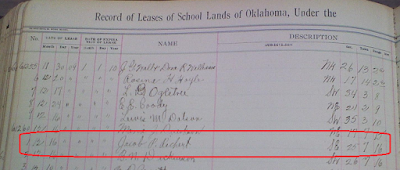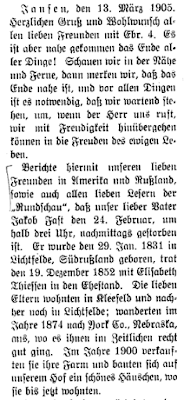On 18 February 1890, my great-grandmother Aganetha (Klassen) Janzen Siemens #6465 (1848-1890) died of puerperal fever. She left behind a grieving husband who now had to care for seven children ranging in age from newborn to twelve years. Understandably my great-grandfather Gerhard T. Siemens #6463 (1834-1908) remarried quickly, on 13 July 1890, to a widow Maria (Peters) Rempel #7038 (1847 - 1930) in Rosenhoff, Manitoba.
The question - should I research anything about his re-marriage? After all, this new wife was not my direct ancestor. In fact, she's not even a collateral relative. You do have to draw the line somewhere about what you are going to resarch, but I think this is not the place for several reasons.
First, any marriage is an important event in the life of a person. My great-grandfather lived with Maria Peters for eighteen years before he died, so it affected him greatly that he married her. Since my grandfather Cornelius K. Siemens was five years old when his mother died, the new wife was really the mother who raised him. Second, it's a vital event (birth, baptism, marriage, death, burial) that I want to document for every ancestor, even if this particular marriage was not the one to which my grandfather was born. Finally, and most importantly, there can be some critical information on the marriage registration. So let's look at how to find the marriage registration and the details of the document.
A searchable index to Manitoba vital records, beginning in 1882, is online
here. When I searched for the marriage, this is the index entry that I found:
 |
| Gerhard Siemens and Maria Peters marriage registration index, 13 July 1890, no. 1890-001447, Vital Statistics Agency, Winnipeg, Manitoba. Accessed online at http://vitalstats.gov.mb.ca/DetailView.php on 3 October 2016. |
This gives proof of the fact of their marriage and the date. At this point, you could be pleased with what you found and think there is no more information on the original and stop. And sometimes you would be right. But in this case it would be a big mistake.
For a mere 12 CAD, you can order a copy of the original, which I did. And Saturday it showed up in my (snail) mailbox. There were no great revelations on it, but there were some interesting facts. First, here is the document:
 |
| Gerhard Siemens and Maria Peters marriage registration, married 13 July 1890, Rosenhoff, Manitoba, registered 4 August 1890, Vital Statistics Agency, Winnipeg, Manitoba, p. 269. |
Note how much more information is on the original. Here are some of the interesting things.
His Parents
Gerhard's parents' full names are given. In fact, this is the only document I have found that gives his mother's maiden name, Gertruda Thiesen. I have a church register that gives his father's wife's maiden name, but the church register doesn't say that that husband and wife are Gerhard's father or mother, so I have to use other documents to demonstrate that connection. So this marriage registration is my only direct connection between Gerhard and his mother.
Her Parents
Maria Peters' parents were previously unknown in the Grandma database. But here it says they are Jacob Peters and Katarina Heidebrecht.
I'm not really interested in her parents, but it might help someone else if I submit this correction to the Grandma database.
 |
| Maria Peters, #7038, Genealogical Registry and Database of Mennonite Ancestry as updated July 2016, California Mennonite Historical Society, Fresno, California. Accessed online at http://www.grandmaonline.org/GW-asp-2/GWIndividual.asp?Ind=7038 on 3 October 2016. |
No parents are listed in the screenshot above, so I submitted a correction by clicking on the button circled in red. Of course, I searched for her parents in the database first, but I wasn't sure that I found them. There was a Jacob Peters #53094 married to a Katharina _____ #53097 who might be her parents, but they don't have a child Maria listed in the database. And I couldn't find that they had a child Maria in the
Molotschna school records. So I added my hunch as a note to the correction that I submitted. Hopefully this will help some of Maria Peters' descendants someday. (For someone who wants to pursue this family, Maria wrote a letter to the
Mennonitische Rundschau that was published on 6 March 1895, in which she lists many of her relatives and either implores them for a letter or thanks them for having communicated.)
Witnesses
The two witnesses to the marriage are interesting as both are former in-laws! Heinrich L. Friesen was the brother-in-law of Gerhard's previous wife, Aganetha Klassen. And Jacob Rempel was the brother of Maria's previous husband. There must not have been animosity with the in-laws since in-laws were witnesses to the marriage. On the contrary, the in-laws likely were happy that a bereaved spouse had found a partner and someone to care for each one's children.
Minister
I have long had a question about what church Gerhard was a member of after about 1880. He was a member of the Kleine Gemeinde to that point,
but shortly after that, the KG suffered a major split where their elder and a third to a half of their members left and joined the Holdemans. Gerhard's oldest stepson, Isaac DeVeer, did join the Holdemans, and several of his children and stepchildren joined the Sommerfelder. Did Gerhard leave the KG? I haven't found any record either way until now.
But the minister who married them, Johann K. Friesen, was a KG minister according to the Grandma database (#3777), so it appears that Gerhard did not leave for the Holdemans and was still KG.
So I hope that I have demonstrated that it is worth finding the original for
every marriage of your ancestors, not just the marriage between your direct ancestors.















